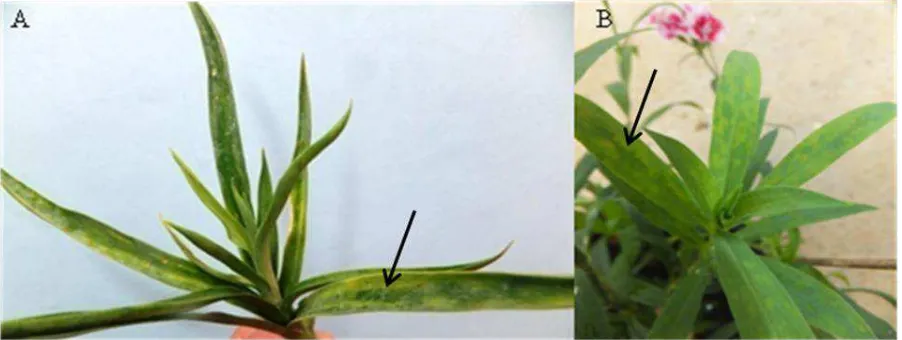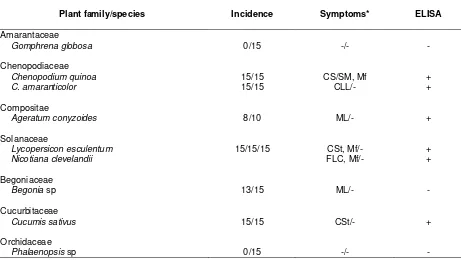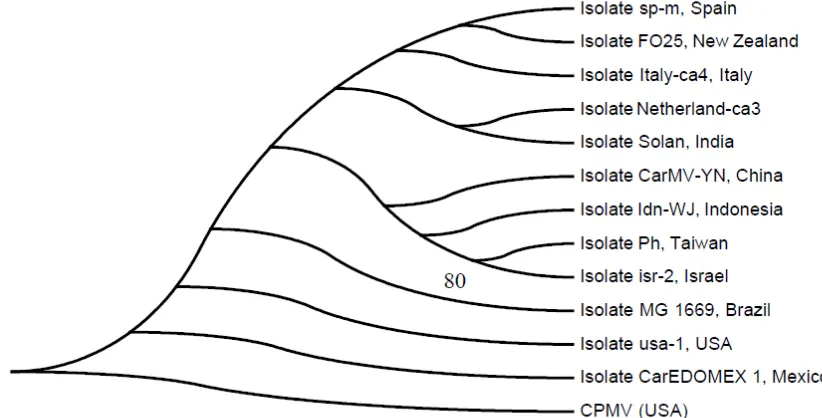AGRIVITA VOLUME 37 No. 2 JUNE - 2015 ISSN : 0126 - 0537
IDENTIFICATION AND CHARACTERIZATION OF CARMOVIRUS ON CARNATION
(
Dianthus caryophyllus
L.) IN WEST JAVA, INDONESIA
Erniawati Diningsih1), Gede Suastika2*), Tri Asmira Damayanti2) and Slamet Susanto3) 1) Indonesian Ornamental Crop Research Institute (IOCRI)
Jl. Raya Ciherang PO BOX 8 SDL 43253 Cianjur West Java Indonesia 2) Department of Plant Protection, Faculty of Agriculture, Bogor Agricultural University,
Campus IPB Darmaga, Jl. Kamper, Bogor 16680 West Java Indonesia
3) Department of Agronomy and Horticulture, Faculty of Agriculture, Bogor Agricultural University, Campus IPB Darmaga, Jl. Meranti, Bogor 16680 West Java Indonesia
*) Corresponding author E-mail: gsuast@gmail.com
Received: February 9, 2015/ Accepted: May 13, 2015
ABSTRACT
Carnation has a highly economic demand of cut flower in Indonesia. Field observations in West Java Indonesia was conducted in order to find the typical mottle symptoms that was a suspect caused by a virus disease. Identification of the virus was respectively conducted by performing ELISA test with four anti sera and characterizations held by bioassay, observing of virion particles, detecting of nucleic acid by RT-PCR and nucleotide sequencing. Total of 403 samples were collected from plants with or no virus-like symptoms. Among those all tested, 83% were found to be infected by Carnation mottle virus (CarMV), but negatively against Carnation ringspot virus (CRSV), Carnation laten virus (CLV), and Carnation vein mottle virus (CVMV) antisera. By mechanical inoculation, the virus was able to infect systemically Cenopodium quinoa and locally infect on others. However on Phalaenopsis sp and Gomprena globosa, there was symptompless found. The isometric CarMV particles size was approximately 30 nm. RT-PCR using specific primers of CP gene of CarMV successfully amplified a DNA sized 1000 bp. CarMV West Java Indonesian (Idn-WJ) isolates possessed the highest nucleotide and amino acid homology with CarMV from Spain and was in the samecluster with CarMV from China, Taiwan and Israel.
Keyword: Dianthus caryhophyllus, RT-PCR, sequence, Tombusviridae
INTRODUCTION
Carnation (Dianthus caryophillus) is one of the major cut flowers in the world since the flower is beautiful with many variation of colors, shapes, and types. The flowers are produced worldwide including Western Europe, Eastern Europe, Latin America, United State of America, Central America, Japan, South east Asia, Australia, Israel (Lisa, 1995), India (Singh et al., 2005) and Turkey (Cevik et al., 2010).
In Indonesia cut flower production of carnation is lower than other ornamental plants i.e. orchid, rose, and chrysanthemum. It is mostly due to lack of pathogen free stocks. Recently, mottle was disease found in various carnation plantations in West Java. Virus-like infected plants showed mild to severe light green to yellowish stripes with unclear boundaries, dark green leaf vein, and curly leaf edges (Figure 1). Occasionally dwarf and curly shoot symptoms were found on certain carnation cultivars.
the virus causal of the disease, thus here we report the identification and characterization the causal of mottle diseases on carnation in West Java, Indonesia.
MATERIALS AND METHODS
The nucleotide sequence reported in this paper is available in the DDBJ/EMBL/GenBank databases under the accession number KP119182.
Time and Place
Research was conducted at the Laboratory of Virology and greenhouse of Indonesia Ornamental Crop Research Institute (IOCRI), and Laboratory of Virology, Department of Plant Protection, Faculty of Agriculture, Bogor Agricultural University.
Samples Collection
Samples were collected from five carnation production areas at Cipanas, Ciputri (Pacet District, Cianjur Regency), Cihideung, Ciwangun (Parongpong District, West Bandung Regency), and Pangalengan (Bandung Regency) in West Java, Indonesia. Randomly, 50-100 samples were collected from each area which consisted of 25-50 samples symptomatic and 25-50 asymptomatic. A total of 403 symptomatic and asymptomatic sample plants were collected and analysed.
Serological Detection
The diseases incidence of viruses were determined serologically (ELISA test) using four antisera such as CarMV antiserum (Agdia, USA), CRSV antiserum (Agdia, USA), CLV antiserum (Agdia, USA), and CVMV antiserum (DSMZ, Germany). ELISA tests were conducted according to protocol provided by Agdia and DSMZ.
Host Range Test
To characterize the biological properties of carnation main virus, host range test was conducted using CarMV of West Java (Idn-WJ) isolate. Inocula were prepared by propagating virus in C. quinoa and grinding the C. quinoa infected leave in phosphate buffer 0.025 M pH 7.6 (Sing et al., 2005). Sap of C. quinoa infected leave was mechanically inoculated by finger to upper of leave of test plants. The sap was inoculated on nine plant species from seven families i.e. Amarantaceae (Gomphrena globo-sa), Solanaceae (Lycopersicon esculentum, Nico-tiana clevelandii), Cucurbitaceae (Cucumis sativus), Begoniaceae (Begonia sp), Compositae (Ageratum conyzoides), Chenopodiaceae (Chenopodium quinoa and C. amaranticolor), and Orchidaceae (Phalaenopsis sp). All tested plants were maintained in insect free green house. The incubation period, disease incidence, and type of symptom were observed daily for at least up to 30 days post inoculation. ELISA test was conducted on test plants at the end of observation.
Electron Microscopy
Morphological observation of virus particles was performed using negative staining of transmission electron microscopy (TEM) in PT Eijkman, Jakarta, Indonesia. Virus particles from infected leaves were prepared as described by Harris (1999).
RT-PCR
Total RNA was extracted from infected leaf tissues of carnation using commercial kit RNeasy plant mini kit (Qiagen, Germany). For reverse transcription reaction (10 µl), the cDNA was synthesized from total RNA using Moloney Murine Leukemia Virus (MMuLV) (Thermo) at 25oC for 5 min, 42oC for 60 min and 70oC for 15 min. Amplification of the cDNA was carried out using a pair of primer specific to CP gene of CarMV. The forward primer was BC57 (5'-GATCGCGATGAATCCCACTGTGC -3') and reverse primer was BC58 (5'-TCACATCCTA TAACAACCATTG-3') with expected PCR product size 1000 bp (Cevik et al., 2010) and PCR program according to Raikhy et al. (2006).
The PCR product was directly sequenced. The nucleotide sequences of the CP gene were aligned with those of other CarMV from GenBank database using Clustal-W (Thompson et al., 1994). Sequences homology analysis of CarMV CP gene were performed using Bio Edit version 7.05 (http://www.mbio.ncsu.edu/ BioEdit/ bioedit.html), and phylogenetic tree was constructed using MEGA 5.0 software with the neighbor-joining algorithm and 1,000 bootstrap replications (Tamura et al., 2011).
RESULTS AND DISCUSSION
Symptoms on Infected Carnation
Most of the carnation plants grown in the field showed light-dark green/mottle symptoms on their leaves (Figure 1). The symptoms varied depended on the carnation cultivars planted in each carnation cultivation area. Chlorosis/mottle and malformation of leaves were dominantly observed on infected plants in Ciputri village,
while severe light-dark spot symptom observed on infected leaves in Cipanas village. Chlorosis streak and stunting was observed dominantly in Ciwangun village. The mottle with no variation symptom on infected plants were observed in Cihideung and Pengalengan villages.
The Disease Incidences of Viruses
Based on ELISA test, it showed that most of samples positively reacted against CarMV antiserum, and negatively against CRSV, CVMV and CLV antisera. Among all of 403 leaf samples tested, 336 samples (83%) were infected by CarMV. It was indicated that CarMV was a dominant virus on carnations in West Java-Indonesia.
Host Range Test
Host range test on nine plant species showed that CarMV infected systemically on C. quinoa. However, there was no obvious symptom on G. globosa and Phalaenopsis sp. CarMV caused local infection on Lycopersicon esculentum, C. amaranticolor, Ageratum conyzoides, Nicotiana clevelandii, Begonia sp, and Cucumis sativus (Table 1).
Symptom on L. esculentum, N. clevelandii, and C. sativus, the local symptom was interveinal chlorosis streak, while on C. amaranticolor was chlorotic local lesions. Symptom on C. quinoa was systemic chlorotic lesions after 6-7 day post inoculation. Leaf malformation was also observed either on local or systemic infection. Rugose was observed on infected leaves of A. conyzoides and Begonia sp.
Electron Microscopy
Table 1. Host range test of CarMV WJ isolate
Plant family/species Incidence Symptoms* ELISA
Amarantaceae
Gomphrena globosa
Chenopodiaceae
Chenopodium quinoa C. amaranticolor
Compositae
Ageratum conyzoides
Solanaceae
Lycopersicon esculentum Nicotiana clevelandii
Begoniaceae
Begonia sp
Cucurbitaceae
Cucumis sativus
Orchidaceae
Phalaenopsis sp
0/15
15/15 15/15
8/10
15/15/15
13/15
15/15
0/15
-/-
CS/SM, Mf CLL/-
ML/-
CSt, Mf/- FLC, Mf/-
ML/-
CSt/-
-/-
-
+ +
+
+ +
-
+
-
Remarks: * On inoculated/upper leaves; CS = Chlorotic Spot; CLL = Chlorotic Local Lesions; ML = Mottle Local; CL = Chlorosis Local; Mf = Malformation; CSt = Chlorotic stripe, FLC = Few local chlorotic, SM = Systemic mottling, - = no symptom. Inoculated/upper leave tissues were assayed 1-2 week after inoculation. ELISA data were considered to be positive if absorbance values of were more than twice those of healty plants.
Nucleotide Sequences Analysis
The RT-PCR of all samples successfully amplified the coat protein gene of CarMV with expected size approximately 1000 bp (data not shown). Based on homology of nucleotide sequences of CP gene, all of West Java isolates were Carnation mottle virus (CarMV) which had similar molecular characteristic with that of isolates from the other countries. The homology of nucleotide sequences of the CP gene among isolates was ranged 92.1 to 96.6% homology for CP nucleotides sequences, and 83.5 to 95.1% homology for CP amino acid sequences (Table 2). The nucleotide sequences of the entire CP gene of WJ isolate (KP119182) had highest identity with that of CarMV from Spain (AJ309509) (97.8% identity for CP nucleotide sequences and 95.1% identity for CP amino acid sequences.
Phylogenetic tree analysis of CarMV CP gene nucleotide of WJ isolate to that of other CarMV isolates deposited in GenBank showed that CarMV WJ isolate was in the same cluster with that of isolates YN (China), Ph (Taiwan) and Isr2 (Israel), however it was distinctive to other isolates (Figure 3).
Based on the above results, it was shown that the mottle symptom on carnations in West Java, Indonesia was caused by CarMV with symptoms similarly reported previously. The typical symptoms that were mild mottle in the
young leaves and faint chlorosis in mature leaves of carnation depended on either cultivar or environmental condition (Calderón and Arbeláez, 1999).
CarMV is considered as an exotic virus since it is a quarantine pest according to quarantine regulation of The Republic of Indonesia. It might enter Indonesia via importation of vegetative propagation materials. Lacking an appropriate detection methods, no obvious virus symptoms on vegetative propagation materials, no clean culture practice in the fields and the lack of availabilities of virus free stock plants may facilitate the rapid distribution of CarMV in West Java.
The incidence of CarMV was dominant and high in the fields, indicating widely distribution of the virus in the fields as previously report in India, Turkey and California-USA (Lommel et al., 1983; Singh et al., 2005; Cevic et al., 2010). The highly incidence of the CarMV might be facilitated by mechanical transmission via cutter such as knives or scissors during preparation of plant materials before planting or during harvesting. SCSMV was also reported rapidly distributed in Java, Indonesia facilitated with similar manner (Damayanti and Putra, 2011). CarMV can be easily transmitted by sap of diseased plants, cuttings scissors or contact between plants (Safari et al., 2009).
Table 2. Homology of nucleotide (nt) and amino acid (aa) of CarMV West Java Isolates (Idn-WJ7) with those of other isolates from West Java and other country established in GenBank
Virus name Accession number (country)
Homology
Nt Aa
Isolate Idn-WJ4 KP119182 (Indonesia) 95.6 89.7
Isolate Italy-Ca4 EF622209.1 (Italy) 95.4 89.1
Isolate Netherland Ca3 EF622211.1 (Netherland) 96.6 92.1
Isolate Isr-2 AJ309501.1 (Israel) 96.6 92.4
Isolate Solan AJ844549.1 (India) 97.2 93.6
Isolate usa-1 AJ309511.1 (USA) 96.5 92.2
Isolate MG 1669 JX207141.1 (Brazil) 97.0 93.6
Isolate sp-m AJ309509.1 (Spain) 97.8 95.1
Isolate carEDOMEX1 KC834739.1 (Mexico) 96.8 92.7
Isolate YN AF173879.1 (China) 97.0 92.7
Isolate Ph HQ117872.1 (Taiwan) 96.5 91.5
Isolate FO25 EF622206.1 (New Zealand) 96.2 90.9
Figure 3. Phylogeny tree of the CP gene of CarMV WJ isolate. The tree was inferred by the Neighbor-Joining method using molecular evolutionary genetics analysis (MEGA) software version 5.05 based on the Clustal W alignment of CarMV sequences from Indonesia with that of 11 CarMV
isolates deposited in GenBank database. The tree was rooted using Cowpea mottle virus
(CPMV) as out groups. Bootstrap values expressed as a percentage of 1,000 replicates.
The CarMV WJ isolate might differ with that of Indian isolate (Singh et al., 2005) based on its ability to infect C.quinoa and G. globosa. WJ isolate caused systemic infection on C. quinoa and was not able to infect G. globosa, while Indian isolate infects locally C. quinoa and G. globosa. The WJ isolate on Phalaenopsis sp was symptompless, while infected Phalaenopsis sp by Taiwan isolate (Zheng et al., 2011) showed chlorotic ring symptom.
The different of environmental conditions between Indonesia and those of countries may cause different environmental stress which lead to different response of isolates to those tested plants. Thus, the different interactions between biotic stress (viral infection) and a abiotic stress (environmental factors) (Conti et al., 2012) can cause different symptom on the same species plants (Hollings and Stone, 1964). Taken together, the WJ isolate might have differ biological characters on those isolates.
CONCLUSION AND SUGGESSION
The results showed that CarMV was found in various varieties of carnations grown in West Java. CarMV can be transmitted mechanically on some type of test plants with different symptoms,
and the symptoms are generally localized. Except on C. quinoa, symptoms are lesions systemic. Isometric structure of 30 nm in diameter of virus particle was obtained, and CarMV West Java Indonesian (Idn-WJ) isolates had the highest nucleotide and amino acid homology with CarMV from Spain. Further research activities need to be done to get effective technology in the release of virus from infected plants.
ACKNOWLEDGEMENTS
This research was supported by Agricultural Research and Development Agencies, Ministry of Agriculture, The Republic of Indonesia.
REFERENCES
Ahmed, A.A., E.A.H. Khatab, R.A. Dawood and A.M. Ismeil. 2012. Evaluation of tip culture and thermotherapy for elimination of Carnation latent virus and Carnation vein mottle virus from Carnation plants. Int. J. of Virology 8 (2): 234-239. doi: 10.3929/ijv. 2012.234.239
of the cuttings and on flower production. Acta Hortic. 482: 179-186.
Cevik, B., T. Bakır and G. Koca. 2010. First report of Carnation mottle virus in Turkey. Plant Pathol. 59: 394. http://onlinelibrary.wiley. com/doi/10.1111/j.13653059.2009.02181. x/abstract. Accessed August 13, 2014. Conti, G., M.C. Rodriguez, C.A. Manacorda and S.
Asurmendi. 2012. Transgenic expression of Tobacco mosaic virus capsid and movement proteins modulate plant basal defense and biotic stress responses in Nicotiana tabacum. Mol. Plant Microbe In. 25 (10): 1370-1384.
Damayanti, T.A. and L.K. Putra. 2011. First occurrence of sugarcane streak mosaic virus infecting sugarcane in Indonesia. J. international committee on taxonomy of viruses. Academic Press, San Diego. Harris, J. Robin. 1999. Negatif staining of thinly
spread biological particulates. In: Nasser Hajibagheri M.A. (Ed.), Electron micros-copy methods and protocols.. Humana press, USA. Vol. 117. p. 13-30
Hollings, M. and O.M. Stone. 1964. Investigation of Carnation viruses. Ann. Appl. Biol. 53 (1): 103-118. doi: 10.1111/j.1744-7348.1964. tb03784.x
Lisa, V. 1995. Carnation. In: Loebenstein G., Lawson R.H. and Brunt A.A. (eds.) Virus and virus like diseases of bulb and flower crops. p. 385-395. Wiley: New York. Lommel, S.A., A.H. McCain, D.E. Mayhew and
T.J. Morris. 1983. Survey of commercial Carnation cultivars for four viruses in California by Indirect ELISA. Plant Dis. 67 (1): 53-56.
Raikhy, G., V. Hallan, S. Kulshrestha, R. Ram and A.A. Zaidi. 2006. Multiplex PCR and genome analysis of Carnation mottle virus Indian isolate. Curr. Sci. India 90 (1):
74-82. http://www.iisc.ernet.in/currsci/ jan 102006/74.pdf. Accessed August 13, 2014.
Safari, M., M.K. Habibi, G. Mosahebi and A. Dizadji. 2009. Carnation mottle virus, an important viral agent infecting Carnation cut-flower crops in Mahallat of Iran. Commun. Agric. Appl. Biol. Sci. 74 (3): 861-865. http://www.ncbi.nlm.nih.gov/ pubmed. Accessed December 22, 2014. Sánchez-Navarro, J.A., M.C. Cañizares, E.A.
Cano and V. Pallás. 1999. Simultaneous detection of five Carnation viruses by non-isotopic molecular hybridization. J. Virol. Methods 82 (2): 167-175. http://www.ncbi. nlm.nih.gov/pubmed/10894633. Accessed December 22, 2014.
Singh, H.P., V. Hallan, G. Raikhy, S. Kulshrestha, M.L. Sharma, R. Ram, I.D. Garg and A.A. Zaidi. 2005. Charac-terization of an Indian isolate of Carnation mottle virus (CarMV) Infecting Carnations. Curr. Sci. India 88 (4): 594-601. http://www.iisc.ernet.in/ currsci/ feb252005/594.pdf. Accessed August 13, 2014.
Tamura, K., D. Peterson, N. Peterson, G. Stecher, M. Nei and S. Kumar. 2011. MEGA5: molecular evolutionary genetics analysis using maximum likelihood, evolutionary distance, and maximum parsimony methods. Mol. Biol. Evol. 28 (10): 2731-2739. doi: 10.1093/molbev/msr121. Thompson, J.D., D.G. Higgins and T.J. Gibson.
1994. CLUSTAL W: Improving the sensitivity of progressive multiple sequence alignment through sequence weighting, position-specific gap penalties and weigh matrix choice. Nucleic Acids Res. 22 (22): 4673-4680.



